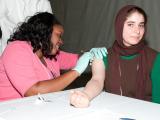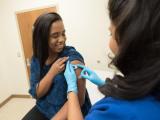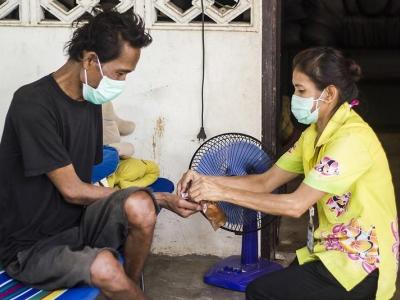Oct 6, 2006 (CIDRAP News) – Many more toddlers received influenza shots in the first flu season after federal health officials began recommending that step 2 years ago, but they remained a minority, according to a report issued yesterday.
In 2004 the Centers for Disease Control and Prevention (CDC) formally recommended flu shots for 6- to 23-month-old children; previously the agency had only "encouraged" vaccination in this age-group. New survey results indicate that 33.4% of those children received at least one dose of flu vaccine for the 2004-05 season, compared with 17.5% the previous season, the CDC said.
Also yesterday, the CDC reported that the self-reported flu immunization rate among people aged 65 and older dropped from 67.6% in 2004 to 63.3% in 2005, probably reflecting the vaccine shortage in the 2004-05 flu season. Both immunization reports were published in today's issue of Morbidity and Mortality Weekly Report.
The findings about toddler immunizations come from the 2005 National Immunization Survey (NIS), an ongoing telephone survey of households, coupled with a mail survey of vaccination providers.
The survey used two measures of vaccination coverage for the 2004-05 season: (1) at least one dose between September and December 2004, and (2) full vaccination, defined as two doses between September and December for children never vaccinated before, or at least one dose in that period for children vaccinated previously.
Based on household responses and the availability of provider vaccination data, 12,056 children were included in the survey. Of these, 33.4% had received at least one dose of flu vaccine, but only 17.8% were considered fully vaccinated, the CDC reports. Those findings compare with estimates of 17.5% for at least one dose and 8.4% for full vaccination in the 2003-04 season.
Immunization rates for toddlers varied widely by location, with single-dose coverage ranging from 9.1% in Clark County, Nev., to 59.3% in Massachusetts, the CDC says.
The report notes that the United States had a shortage of flu vaccine in 2004-05 because one manufacturer (Chiron) couldn't deliver the doses it had planned to. However, the shortage didn't directly affect the supply for toddlers, because Chiron's vaccine was not licensed for children under 4 years old.
A previous CDC survey, from the Behavioral Risk Factor Surveillance System (BRFSS), yielded a higher estimate of flu immunization among toddlers in 2004-05: 48.4%. Several factors may explain the difference, the article says.
The BRFSS figures are based on reports from parents and are not confirmed by healthcare providers, which might result in overestimates, the CDC says. In addition, the BRFSS used a different definition of the 6- to 23-month-old age-group and a slightly longer vaccination period.
Flu shots in elderly sagged in 2005
The CDC report of a drop in flu immunization among older people in 2005 came from BRFSS surveys. In the 2004 and 2005 surveys, people were asked whether they had had a flu shot in the preceding 12 months. Survey respondents who were 65 or older numbered 68,514 in 2004 and 87,351 in 2005.
In 2005, 63.3% of the elderly respondents said they'd had a flu shot, compared with 67.6% in 2004. The decline in coverage was statistically significant in 16 states, and it exceeded 10% in 13 of those states, the CDC reports.
State immunization rates for the elderly varied widely in both years; in 2005 they ranged from 35.3% in Puerto Rico to 78.8% in Minnesota, with a median of 65.5%. Among the states, the median drop in coverage was 5.1%.
To assess vaccination coverage in the 2003-04 and 2004-05 flu seasons, the CDC did a separate analysis of the findings from people interviewed in the first 6 months of each of the 2 years. Most people questioned during those periods were reporting on vaccinations received between the preceding September and December, the article says.
This analysis revealed a steeper decline in flu immunization than was found in the full-year analysis. In the first half of 2005, 64% of respondents said they had been immunized, down from 73.8% in the first half of 2004. Coverage declined in all but two states and territories; the decreases ranged from 3.2% to 23.7%, with a median of 12.0%. The decline was significant in 44 states and greater than 10% in nine of them.
The CDC says the findings suggest that elderly people were affected by the vaccine shortage in 2004-05. About 61 million doses were produced for that season, compared with 87 million the previous season and 95 million in 2002-03, the report says.
In response to the supply problems of recent years, the article says the CDC is working with manufacturers and distributors to improve a vaccine-supply tracking system that was first devised in the 2004-05 season.
Unlike flu immunizations, pneumococcal vaccination coverage in the elderly was stable over the 2 years. In 2005, 63.7% of respondents reported ever having received pneumococcal vaccine, compared with 63.4% in 2004. Coverage in 2005 ranged from 28.3% in Puerto Rico to 71.7% in North Dakota, with a median of 65.7%.
The government has set goals of increasing flu and pneumococcal vaccination coverage among the elderly to 90% by 2010.
CDC. Childhood influenza vaccination coverage—United States, 2004-05 influenza season. MMWR 2006 Oct 6;55(39):1061-5 [Full text]
CDC. Influenza and pneumococcal vaccination coverage among persons aged >65 years—United States, 2004-2005. MMWR 2006 Oct 6;55(39):1065-8 [Full text]

















